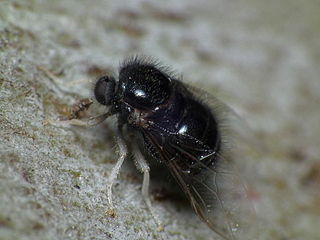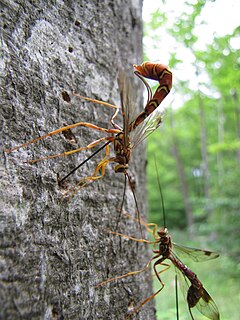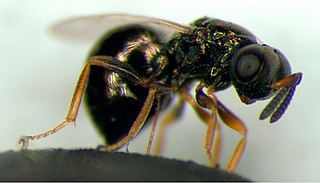
The ovipositor is a tube-like organ used by some animals, especially insects, for the laying of eggs. In insects, an ovipositor consists of a maximum of three pairs of appendages. The details and morphology of the ovipositor vary, but typically its form is adapted to functions such as preparing a place for the egg, transmitting the egg, and then placing it properly. For most insects, the organ is used merely to attach the egg to some surface, but for many parasitic species, it is a piercing organ as well.

In evolutionary ecology, a parasitoid is an organism that lives in close association with its host at the host's expense, eventually resulting in the death of the host. Parasitoidism is one of six major evolutionary strategies within parasitism, distinguished by the fatal prognosis for the host, which makes the strategy close to predation.

The Tachinidae are a large and variable family of true flies within the insect order Diptera, with more than 8,200 known species and many more to be discovered. Over 1,300 species have been described in North America alone. Insects in this family commonly are called tachinid flies or simply tachinids. As far as is known, they all are protelean parasitoids, or occasionally parasites, of arthropods, usually other insects. The family is known from many habitats in all zoogeographical regions and is especially diverse in South America.

Kleptoparasitism is a form of feeding in which one animal deliberately takes food from another. The strategy is evolutionarily stable when stealing is less costly than direct feeding, which can mean when food is scarce or when victims are abundant. Many kleptoparasites are arthropods, especially bees and wasps, but including some true flies, dung beetles, bugs, and spiders. Cuckoo bees are specialized kleptoparasites which lay their eggs either on the pollen masses made by other bees, or on the insect hosts of parasitoid wasps. They are an instance of Emery's rule, which states that insect social parasites tend to be closely related to their hosts. The behavior occurs, too, in vertebrates including birds such as skuas, which persistently chase other seabirds until they disgorge their food, and carnivorous mammals such as spotted hyenas and lions. Other species opportunistically indulge in kleptoparasitism.

Paper wasps are vespid wasps that gather fibers from dead wood and plant stems, which they mix with saliva, and use to construct nests made of gray or brown papery material. Some types of paper wasps are also sometimes called umbrella wasps, due to the distinctive design of their nests.

The Ichneumonidae, also known as the ichneumon wasps, Darwin wasps, or ichneumonids, are a family of parasitoid wasps of the insect order Hymenoptera. They are one of the most diverse groups within the Hymenoptera with roughly 25,000 species currently described. However, this likely represents less than a quarter of their true richness as reliable estimates are lacking, along with much of the most basic knowledge about their ecology, distribution, and evolution. Ichneumonid wasps, with very few exceptions, attack the immature stages of holometabolous insects and spiders, eventually killing their hosts. They thus fulfill an important role as regulators of insect populations, both in natural and semi-natural systems, making them promising agents for biological control.

The Drosophilidae are a diverse, cosmopolitan family of flies, which includes species called fruit flies, although they are more accurately referred to as vinegar or pomace flies. Another distantly related family of flies, Tephritidae, are true fruit flies because they are frugivorous, and include apple maggot flies and many pests. The best known species of the Drosophilidae is Drosophila melanogaster, within the genus Drosophila, also called the "fruit fly." Drosophila melanogaster is used extensively for studies concerning genetics, development, physiology, ecology and behaviour. Many fundamental biological mechanisms were discovered first in D. melanogaster. The fruit fly is mostly composed of post-mitotic cells, has a very short lifespan, and shows gradual aging. As in other species, temperature influences the life history of the animal. Several genes have been identified that can be manipulated to extend the lifespan of these insects. Additionally, Drosophila subobscura, also within the genus Drosophila, has been reputed as a model organism for evolutionary-biological studies, along with D. sechellia for the evolution of host specialization on the toxic noni fruit and Scaptomyza flava for the evolution of herbivory and specialist on toxic mustard leaves.

The Tephritidae are one of two fly families referred to as fruit flies, the other family being the Drosophilidae. The family Tephritidae does not include the biological model organisms of the genus Drosophila, which is often called the "common fruit fly". Nearly 5,000 described species of tephritid fruit fly are categorized in almost 500 genera of the Tephritidae. Description, recategorization, and genetic analyses are constantly changing the taxonomy of this family. To distinguish them from the Drosophilidae, the Tephritidae are sometimes called peacock flies, in reference to their elaborate and colorful markings. The name comes from the Greek τεφρος, tephros, meaning "ash grey". They are found in all the biogeographic realms.

The Braconidae are a family of parasitoid wasps. After the closely related Ichneumonidae, braconids make up the second-largest family in the order Hymenoptera, with about 17,000 recognized species and many thousands more undescribed. One analysis estimated a total between 30,000 and 50,000, and another provided a narrower estimate between 42,000 and 43,000 species.

Cyclostomatida, or cyclostomata, are an ancient order of stenolaemate bryozoans which first appeared in the Lower Ordovician. It consists of 7+ suborders, 59+ families, 373+ genera, and 666+ species. The cyclostome bryozoans were dominant in the Mesozoic; since that era, they have decreased. Currently, cyclostomes seldom constitute more than 20% of the species recorded in regional bryozoan faunas.
Cyclostome is a biological term used in a few different senses:

The Acroceridae are a small family of odd-looking flies. They have a hump-backed appearance with a strikingly small head, generally with a long proboscis for accessing nectar. They are rare and not widely known. The most frequently applied common names are small-headed flies or hunch-back flies. Many are bee or wasp mimics. Because they are parasitoids of spiders, they also are sometimes known as spider flies.

Parasitoid wasps are a large group of hymenopteran superfamilies, with all but the wood wasps (Orussoidea) being in the wasp-waisted Apocrita. As parasitoids, they lay their eggs on or in the bodies of other arthropods, sooner or later causing the death of these hosts. Different species specialise in hosts from different insect orders, most often Lepidoptera, though some select beetles, flies, or bugs; the spider wasps (Pompilidae) exclusively attack spiders.

Nasonia are a genus of small pteromalid parasitoid wasps that sting and lay eggs in the pupae of various flies. The fly species that Nasonia usually parasitize are primarily blow flies and flesh flies, making Nasonia a useful tool for biocontrol of these pest flies. The small match-head sized wasps are also referred to as jewel wasps based on the emerald sheen of their exoskeleton.

The Doryctinae or doryctine wasps are a large subfamily of braconid parasitic wasps (Braconidae). Numerous genera and species formerly unknown to science are being described every year. This subfamily is presumably part of a clade containing otherwise any or all of the Alysiinae, Braconinae, Gnamptodontinae, Opiinae and Ypsistocerinae, and might be most closely related to the last one of these. Whether the Rogadinae are also part of this group is not known.

Dinotrema is a genus of wasps in the family Braconidae. Species are amongst the largest parasitoid wasps in the tribe Alysiini (Alysiinae). There are approximately 350 species described around worldwide.

The Braconinae are a large subfamily of braconid parasitoid wasps with more than 2,000 described species. Many species, including Bracon brevicornis, have been used in biocontrol programs.

The Cenocoeliinae are a subfamily of braconid parasitoid wasps.
Apozyx is a genus of braconid parasitic wasps with only one species, Apozyx penyai. It is the only genus in the subfamily Apozyginae. This subfamily was originally proposed as a separate family by Mason in 1978.
The Homolobinae are a subfamily of braconid parasitoid wasps. The subfamily Charmontinae was previously included within Homolobinae as the tribe Charmontini.


















